Bonnie Prince Charlie portrait that of younger brother

Your support helps us to tell the story
From reproductive rights to climate change to Big Tech, The Independent is on the ground when the story is developing. Whether it's investigating the financials of Elon Musk's pro-Trump PAC or producing our latest documentary, 'The A Word', which shines a light on the American women fighting for reproductive rights, we know how important it is to parse out the facts from the messaging.
At such a critical moment in US history, we need reporters on the ground. Your donation allows us to keep sending journalists to speak to both sides of the story.
The Independent is trusted by Americans across the entire political spectrum. And unlike many other quality news outlets, we choose not to lock Americans out of our reporting and analysis with paywalls. We believe quality journalism should be available to everyone, paid for by those who can afford it.
Your support makes all the difference.It seems ironic for the man who in life was hailed by his Jacobite followers as the Young Pretender and disguised himself as an Irish maid to escape the clutches of his foes that in death he should become the victim of mistaken identity.
But today it emerged that a portrait of Charles Edward Stuart, better known as Bonnie Prince Charlie, that has hung in pride of place in the Scottish National Portrait Gallery for 15 years is not who it clams to be.
Following a two-year wrangle over the armour-clad subject of the portrait by French artist Maurice Quentin la Tour, the Edinburgh gallery conceded that it was most likely not the romantic hero of the Tudor claim after all.
Instead, it is believed the pastel, purchased in 1992 for £22,000 is in fact of Charles’ younger brother Henry Benedict who was a Duke and Cardinal of York.
The mix-up is particularly embarrassing because the image has become something of an icon of Scottish romantic sentiment, gracing the cover and pages of a number of important books on the prince as well as the Oxford Dictionary of National Biography.
A National Galleries of Scotland spokesman said it had reassessed the picture after Dr Edward Corp of the University of Toulouse, France, an expert on Jacobite portraiture, reversed his earlier position that it was the Bonnie Prince himself.
Writing in The British Art Journal he said the change of mind was important. “Whether the portrait does or does not show Prince Charles really does matter. It is not merely the catalogue of the Scottish National Portrait Gallery which needs to be corrected. The impression which an entire nation has derived of this important historical figure should also be changed,” he said. Doubts first surfaced last year after a painting "Portrait of a Cardinal" was purchased by London art dealers Philip Mould. It was later identified as a lost portrait of another brother Henry Stuart.
Though Charles Stuart has a special place in the pantheon of Scottish heroes he was in fact born in Italy. As the grandson of James II and VII he was considered the Catholic dynasty’s best shot at retaking the throne after being routed by the Protestant forces of William Orange in 1688. Charles landed in Scotland in 1745 where he enjoyed quick victories before marching on England – an adventure that suddenly stalled at Derby. Charles led his forces to slaughter at Cullodon before making the much celebrated escape across the sea to Skye (dressed as the Irish maid) and from there to a continental exile marked by heavy drinking and numerous affairs.
A spokesman for the gallery said the picture would go back on show when building work was completed along with a new panel describing the furore over its identification: "It is not uncommon that such re-attributions are made, as research continues to fill in gaps in our knowledge, and it is always exciting to uncover new information about the works in our care. None of these debates detract from the greatness of the portrait,” he said.
What was the most memorable arts event of 2009? In the comments form below (or via email to arts@independent.co.uk) nominate your favourite - in film, music, theatre, comedy, dance or visual arts - with a brief explanation as to why it tops your list and we'll print a selection in The Independent Readers' Review of 2009.
Join our commenting forum
Join thought-provoking conversations, follow other Independent readers and see their replies
Comments